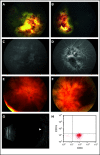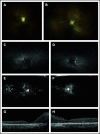Bilateral retinal detachment after chimeric antigen receptor T-cell therapy
- PMID: 32428218
- PMCID: PMC7252550
- DOI: 10.1182/bloodadvances.2020001450
Bilateral retinal detachment after chimeric antigen receptor T-cell therapy
Abstract
CAR T-cell targeting of leukemic infiltrates in the optic nerve and retina caused retinal detachment as a presentation of pseudoprogression.
Treatment of this intraocular inflammation with intravitreal triamcinolone and orbital radiation led to marked improvement in visual acuity.
Conflict of interest statement
Conflict-of-interest disclosure: The authors declare no competing financial interests.
Figures



References
-
- Rossi JF, Lu ZY, Jourdan M, Klein B. Interleukin-6 as a therapeutic target. Clin Cancer Res. 2015;21(6):1248-1257. - PubMed
Publication types
MeSH terms
Substances
LinkOut - more resources
Full Text Sources
Medical

